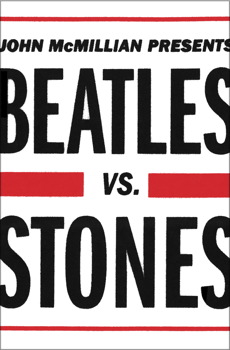New Faculty Publication: Beatles vs. Stones
 John McMillian of the Department of History has recently published Beatles vs. Stones, a lively discussion of the complex relationship between two legendary bands which dominated rock culture during the 1960s and well beyond. Recently reviewed in the New York Times, Beatles vs. Stones is based on extensive primary-source research, including but not limited to underground newspapers to teen magazines.
John McMillian of the Department of History has recently published Beatles vs. Stones, a lively discussion of the complex relationship between two legendary bands which dominated rock culture during the 1960s and well beyond. Recently reviewed in the New York Times, Beatles vs. Stones is based on extensive primary-source research, including but not limited to underground newspapers to teen magazines.
“In the 1960s the two biggest bands in the world—the lovable Beatles and the bad-boy Rolling Stones—waged an epic battle. “The Beatles want to hold your hand,” wrote Tom Wolfe, “but the Stones want to burn down your town.” Both groups liked to maintain that they weren’t really “rivals”—that was just a media myth, they politely said—but on both sides of the Atlantic, they plainly competed for commercial success and aesthetic credibility. In Beatles vs. Stones, John McMillian gets to the truth behind the ultimate rock ’n’ roll debate.
McMillian reveals how music managers helped to construct the Beatles-Stones rivalry as they set out to engineer moneymaking empires. He explores how the Beatles were marketed as cute and amiable, when in fact they came from hardscrabble backgrounds in Liverpool. By contrast, the Stones were cast as an edgy, dangerous group, even though they mostly hailed from the London suburbs. Although the Beatles always sold more records than the Stones, the Stones seemed to win greater credibility with the “right” types of fans: discerning bohemians, as opposed to hysterical teenyboppers. Later, the Beatles embraced Flower Power, while the Stones briefly aligned themselves with New Left militance. Ever since, writers and historians have associated the Beatles with the gauzy idealism of the “good” sixties and portrayed the Stones as representatives of the dangerous and nihilistic “bad” sixties. Beatles vs. Stones explodes that split.
In a lively narrative that whisks readers from Liverpool to London to New York City—and to various recording studios, nightclubs, concerts, courtrooms, and protest rallies in between—McMillian also delves into the personal relationships between the two groups. In one chapter we see Lennon and McCartney huddle up in a rehearsal space and show the Stones how to write their own material; in another we eavesdrop on Jagger and Richards as they watch the Beatles play Shea Stadium from the visitors’ dugout. McMillian also shows us how the two groups feuded about which act would headline a legendary Poll Winners’ concert and the pernicious effect that the American businessman Allen Klein had on both bands.” (From publisher’s information)
Prof. McMillian, an Assistant Professor in the Department of History, has also published the following:
- Smoking Typewriters: The Sixties Underground Press and the Rise of Alternative Media in America (2011)
- The New Left Revisited (2003; co-edited with Paul Buhle)
- Freedom on My Mind: The Columbia Documentary History of the African American Experience (2003; assistant editor with Nishani Frazier; Manning Marable, general editor)
- Radical Reader: A Documentary History of the American Radical Tradition (2003; co-edited with Timothy Patrick McCarthy, foreword by Eric Foner
Prof. McMillian is also an editor for The Sixties: A Journal of History, Politics, and Culture (also available to GSU affiliates here), and has contributed short essays and book reviews to the Washington Post, The Nation, The Chronicle of Higher Education, the New York Observer, the Boston Globe, the Believer, and elsewhere.
Want to learn more about these bands? The Georgia State University Library also has these resources, among others, on the boys who “wanna hold your hand”:
- Paul Charles, Best Beatles Book Ever (2013)
- Martin King, Men, Masculinity, and the Beatles (2013)
- A. J. Millard, Beatlemania: Technology, Business, and Teen Culture in Cold War America (2013)
- Kate Siobhan Mulligan, Beatles: A Musical Biography (2010)
On the other side, on the boys who “wanna tear your world apart,” we have:
- Helmut Staubman, ed., Rolling Stones: Sociological Perspectives (2013)
- Simon Wells, Butterfly on a Wheel: The Great Rolling Stones Drug Bust (2011)
- Keith Richards, with James Fox, Life (2010)
- Robert Greenfield, Exile on Main Street: A Season in Hell with the Rolling Stones (2006)
To watch these bands in action, try these films, available in our audiovisual collection on Library North 1 (guess which films represent which band!):
- A Hard Day’s Night (2002; original, 1964)
- Help! (2007; original, 1965)
- The Four Complete Ed Sullivan Shows Starring the Beatles (2010; originals, 1964-1965)
- Sympathy for the Devil (2003; original, 1970)
- Gimme Shelter (2000, 30th anniversary version)
To find more resources on these bands (or other bands!) try a subject search in the library catalog or in the Discover search using the name of the band as the subject term.
For a wealth of primary sources relating to popular music and 1960s culture, try these databases:
- Rock and Roll, Counterculture, Peace and Protest
- Entertainment Industry Magazine Archive (includes film, music, broadcasting and theater industry magazines, along with film fan magazines and music press titles)
- Reader’s Guide Retrospective, 1890-1982 (index to popular magazines; try searching for “Beatles” or “Rolling Stones”)
- New York Times (Historical) (try searching by band name)